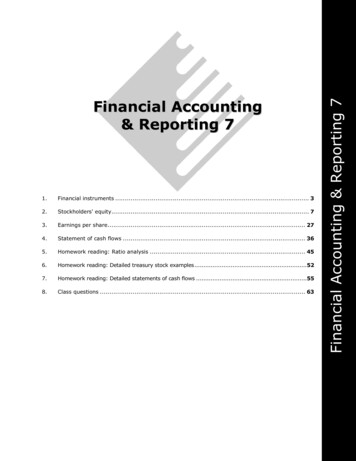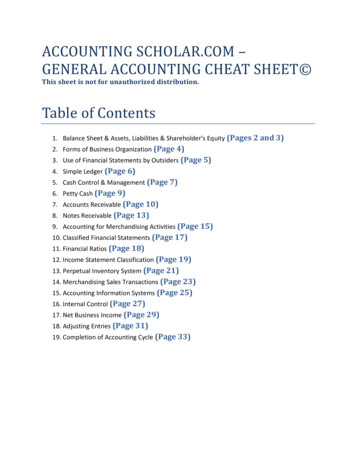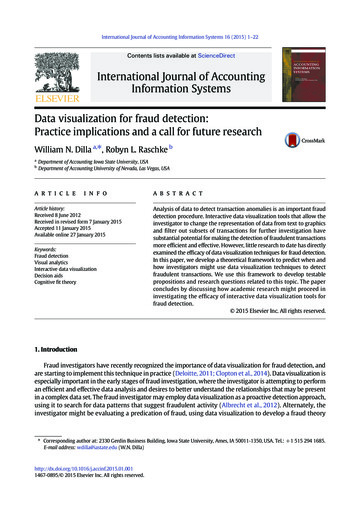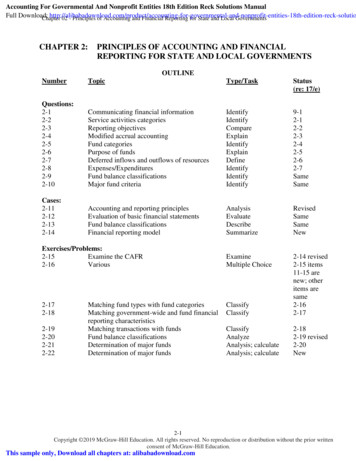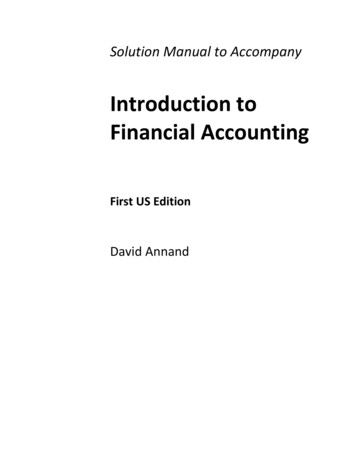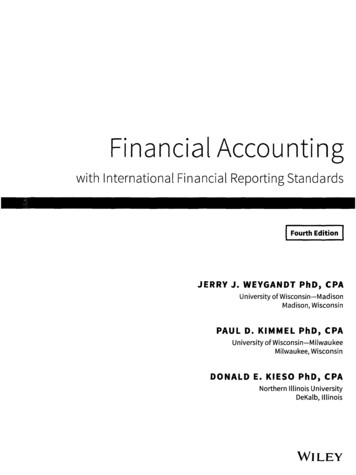
Transcription
FinancialAccountingwith International Financial Reporting StandardsFourth EditionJERRY J. WEYGANDT PhD, CPAUniversity of Wisconsin—MadisonMadison, WisconsinPAUL D. KIMMEL PhD, CPAUniversity of Wisconsin—MilwaukeeMilwaukee, WisconsinDONALD E. KIESO PhD, CPANorthern Illinois UniversityDeKalb, IllinoisWILEY
1 Accountingin Action1-1Knowing the Numbers 1-1Accounting Activities and Users 1-3Three Activities 1-3Who Uses Accounting Data 1-4The Building Blocks of Accounting 1-6Ethics in Financial Reporting 1-6Accounting Standards 1-7Measurement Principles 1-8Assumptions 1-8The Accounting Equation 1-10Assets 1-11Liabilities 1-11Equity 1-11Analyzing Business Transactions 1-13Accounting Transactions 1-13Transaction Analysis 1-14Summary of Transactions 1-19Financial Statements 1-20Income Statement 1-22Retained Earnings Statement 1-22Statement of Financial Position 1-22Statement of Cash Flows 1-23Comprehensive Income Statement 1-23Appendix 1A: Career Opportunities in Accounting 1-25Public Accounting 1-25Private Accounting 1-26Governmental Accounting 1-26Forensic Accounting 1-26A Look at U.S. GAAP 1-462The Recording ProcessAccidents Happen: Bank of Taiwan 2-1Accounts, Debits, and Credits 2-2The Account 2-2Debits and Credits 2-3Equity Relationships 2-6Summary of Debit/Credit Rules 2-6The Journal 2-7The Recording Process 2-7The Journal 2-8The Ledger and Posting 2-10The Ledger 2-10Posting 2-12Chart of Accounts 2-13The Recording Process lllustrated 2-13viii2-1Summary Illustration of Journatizing and PostingThe Trial Balance 2-21Limitations ofa Trial Balance 2-22Locating Errors 2-22Currency Signs and Underlining 2-22A Look at U.S. GAAP 2-463Adjusting the Accounts2-193-1What Was Your Profit?: Cadbury 3-1Accrual-Basis Accounting and Adjusting Entries 3-2Fiscal and CalendarYears 3-3Accrual- versus Cash-Basis Accounting 3-3Recognizing Revenues and Expenses 3-3The Need for Adjusting Entries 3-5Types of Adjusting Entries 3-5Adjusting Entries for Deferrals 3-6Prepaid Expenses 3-6Unearned Revenues 3-10Adjusting Entries for Accruals 3-13Accrued Revenues 3-13Accrued Expenses 3-14Summary of Basic Relationships 3-17Adjusted Trial Balance and Financial Statements 3-20Preparing the Adjusted Trial Balance 3-21Preparing Financial Statements 3-21Appendix 3A: Alternative Treatment of Deferrals 3-24Prepaid Expenses 3-25Unearned Revenues 3-26Summary of AdditionalAdjustment Relationships 3-27Appendix 3B: Financial Reporting Concepts 3-28Qualities of Useful Information 3-28Assumptions in Financial Reporting 3-28Principles in Financial Reporting 3-29Cost Constraint 3-30A Look at U.S. GAAP 3-564Completing the AccountingCycle4-iSpeaking the Same Language: IASB 4-1The Worksheet 4-3Steps in Preparing a Worksheet 4-3Preparing Financial Statements from a Worksheet 4-10Preparing Adjusting Entries from a Worksheet 4-11Closing the Books 4-11Preparing Closing Entries 4-12
Contents ixPosting Closi ng Entries 4-14Preparing a Post-Closing Trial Balance 4-16The Accounting Cycle and Correcting Entries 4-19Summaryof the Accounting Cycle 4-19Reversing Entries—An Optional Step 4-19Correcting Entries—An Avoidable Step 4-19Classified Statement of Financial Position 4-23IntangibleAssets 4-24Property, Plant, and Equipment 4-25Long-Term Investments 4-25Current Assets 4-25Equity 4-26Non-Current Liabilities 4-27Current Liabilities 4-27Appendix 4A: Reversing Entries 4-29Reversing Entries Example 4-29A Look at U.S. GAAP 4-575Accounting for MerchandiseOperations5-1Who Doesn't Shop?: Carrefour 5-1Merchandising Operations and Inventory Systems 5-3OperatingCycles 5-3Flow of Costs 5-4Recording Purchases Under a Perpetual System 5-6Freight Costs 5-8Purchase Returns and Allowances 5-9Purchase Discounts 5-9Summary of Purchasing Transactions 5-10Recording Sales Under a Perpetual System 5-11Sales Returns and Allowances 5-12Sales Discounts 5-13The Accounting Cycle for a Merchandising Company 5-14Adjusting Entries 5-15Closing Entries 5-15Summary of Merchandising Entries 5-16Financial Statements for a Merchandiser 5-17Income Statement 5-17Classified Statement of Financial Position 5-21Appendix 5A: Worksheet for a MerchandisingCompany 5-23Using a Worksheet 5-23Appendix 5B: Periodic Inventory System 5-24Determining Cost of Goods Sold Under a PeriodicSystem 5-25Recording Merchandise Transactions 5-25Recording Purchases of Merchandise 5-26Recording Sales of Merchandise 5-27Journalizing and Posting Closing Entries 5-27Using a Worksheet 5-29A Look at U.S. GAAP 5-546Inventories 6-1"Where Is That Spare Bulldozer Blade?":Komatsu 6-1Classifying and Determining Inventory 6-2Classifying Inventory 6-2Determining Inventory Quantities 6-4Inventory Methods and Financial Effects 6-6Specific Identification 6-7Cost Flow Assumptions 6-7Financial Statement and Tax Effects of Cost FlowMethods 6-11Using Inventory Cost Flow Methods Consistently 6-12Effects of Inventory Errors 6-13Income Statement Effects 6-13Statement of Financial Position Effects 6-14Inventory Statement Presentation and Analysis 6-15Presentation 6-15Lower-of-Cost-or-Net RealizableValue 6-15Analysis 6-16Appendix 6A: Inventory Cost Flow Methods in PerpetualInventory Systems 6-18First-In, First-Out (FIFO) 6-18Average-Cost 6-19Appendix 6B: Estimating Inventories 6-19Gross Profit Method 6-20Retail Inventory Method 6-21Appendix 6C: LIFO Inventory Method 6-22A Look at U.S. GAAP 6-447Fraud, Internal Control,and Cash7-1Minding the Money at Nick's: Nick's Steakhouse andPizza 7-1Fraud and Internal Control 7-2Fraud 7-3Internal Control 7-3Principles of Internal Control Activities 7-4Limitations of Internal Control 7-10Cash Controls 7-10Cash Receipts Controls 7-11Cash Disbursements Controls 7-13Petty Cash Fund 7-15Control Features of a Bank Account 7-18Making Bank Deposits 7-18WritingChecks 7-19Electronic Funds Transfer (EFT) System 7-20Bank Statements 7-20Reconciling the Bank Account 7-21Reporting Cash 7-26
x ContentsCash Equivalents 7-26Restricted Cash 7-26A Look at U.S. GAAP 7-46810 Current LiabilitiesAccountingfor Receivabless-iAre You Going to Pay Me—or Not?: BNP Paribas 8-1Recognition of Accounts Receivable 8-2Typesof Receivables 8-3Recognizing Accounts Receivable 8-3Valvation and Disposition of Accounts Receivable 8-5Valuing Accounts Receivable 8-5Disposing of Accounts Receivable 8-11Notes Receivable 8-13Determining the Maturity Date 8-14Computing Interest 8-15Recognizing Notes Receivable 8-15Valuing Notes Receivable 8-16Disposing of Notes Receivable 8-16Presentation and Analysis 8-18Presentation 8-19Analysis 8-19A Look at U.S. GAAP 8-389Plant Assets, Natural Resources,and Intangible Assets9-1How Much for a Ride to the Beach?: Rent-A-WreckPlant Asset Expenditures 9-2Determining the Cost of Plant Assets 9-3Expenditures Düring Useful Life 9-5Depreciation Methods 9-7Factors in Computing Depreciation 9-8Depreciation Methods 9-8Component Depreciation 9-13Depreciation and Income Taxes 9-13Revaluation of Plant Assets 9-13Revising Periodic Depreciation 9-14Plant Asset Disposals 9-15Retirement of Plant Assets 9-16Sale of Plant Assets 9-16Natural Resources and Intangible Assets 9-18Natural Resources and Depletion 9-18Intangible Assets 9-20Statement Presentation and Analysis 9-23Presentation 9-23Analysis 9-24Appendix 9A: Exchange of Plant Assets 9-24LossTreatment 9-25Gain Treatment 9-25A Look at U.S. GAAP 9-479-110-1Financing His Dreams: Wilbert Murdock 10-1Accounting for Current Liabilities 10-2What Is a Current Liability? 10-2Notes Payable 10-3Value-Added and Sales Taxes Payable 10-4Unearned Revenues 10-5Satariesand Wages 10-5Current Maturities of Long-Term Debt 10-7Report!ng and Analyzing Current Liabilities 10-8Reporting Uncertainty 10-8Reporting of Current Liabilities 10-9Analysis of Current Liabilities 10-10A Look at U.S. GAAP 10-2611 Non-Current Liabilities11-1Are We Living on Borrowed Time? 11-1Overview of Bonds 11-2Typesof Bonds 11-3Issuing Procedures 11-3Bond Trading11-3Determining the Market Price of a Bond 11-4Bond Transactions 11-6Issuing Bondsat Face Value 11-6Discount or Premium on Bonds 11-7Issuing Bonds ata Discount 11-8Issuing Bonds at a Premium 11-9Redeeming Bonds 11-10Accounting for Non-Current Liabilities 11-11Long-Term Notes Payable 11-11Lease Liabilities 11-13Reporting and Analyzing Non-Current Liabilities 11-14Presentation 11-14Analysis 11-14Debt and Equity Financing 11-15Appendix IIA: Effective-Interest Method of BondAmortization 11-17Amortizing Bond Discount 11-17Amortizing Bond Premium 11-19Appendix IIB: Straight-Line Amortization 11-20Amortizing Bond Discount 11-20Amortizing Bond Premium 11-21A Look at U.S. GAAP 11-3812 Corporations: Organization, ShareTransactions, and EquityTo the Victor Go the Spoils: adidas 12-1The Corporate Form of Organization 12-2Characteristics of a Corporation 12-312-1
Contents xiForming a Corporation 12-5Shareholder Rights 12-5Share Issue Considerations 12-7Corporate Capital 12-9Accounting for Share Transactions 12-10Accounting for Ordinary Shares 12-10Accounting for Preference Shares 12-12Accounting for Treasury Shares 12-13Dividends and Splits 12-16Accounting for Cash Dividends 12-17Dividend Preferences 12-18Accounting for Share Dividends 12-21Accounting for Share Splits 12-23Reporting and Analyzing Equity 12-24Retained Earnings 12-24Presentation of Statement of Financial Position 12-26Analysis 12-27Appendix 12A: Statement of Changes in Equity 12-28Appendix 12B: Book Value—Another per ShareAmount 12-29Book Value per Share 12-29Book Value versus Market Price 12-30A Look at U.S. GAAP 12-5513 InvestmentsSignificant Non-Cash Activities 14-5Format ofthe Statement of Cash Flows 14-5Preparing the Statement of Cash Flows—IndirectMethod 14-7Indirect and Direct Methods 14-8Indirect Method—Computer ServicesInternational 14-8Step 1: Operating Activities 14-9Summary of Conversion to Net Cash Providedby Operating Activities—Indirect Method 14-12Step 2: Investing and Financing Activities 14-13Step 3: Net Change in Cash 14-14Using Cash Flows to Evaluate a Company 14-17Free Cash Flow 14-17Appendix 14A: Statement of Cash Flows—DirectMethod 14-19Step 1: Operating Activities 14-21Step 2: Investing and Financing Activities 14-25Step 3: Net Change in Cash 14-26Appendix 14B: Statement of Cash Flows—T-AccountApproach 14-26A Look at U.S. GAAP 14-5015 Financial Analysis: The Big13-1PicturePlaying for Fun and Profit: Sony 13-1Debt Investments 13-2Why Companies Invest 13-2Accounting for Debt Investments 13-4Share Investments 13-6Holdings of Less than 20% 13-6Holdings Between 20% and 50% 13-7Holdings of More than 50% 13-8Valuing and Reporting Investments 13-10Categoriesof Securities 13-10Statement of Financial Position Presentation 13-16Presentation of Realized and Unrealized Gain or Loss 13-17Classified Statement of Financial Position 13-17Appendix 13A: Preparing Consolidated FinancialStatements 13-19Consolidated Statement of Financial Position 13-19Consolidated Income Statement 13-23A Look at U.S. GAAP 13-40is-iMaking Money the Old-Fashioned Way: Li Ka-shing 15-1Basics of Financial Statement Analysis 15-2Need for Comparative Analysis 15-3Tools of Analysis 15-3Horizontal Analysis 15-3Vertical Analysis 15-6Ratio Analysis 15-9Liquidity Ratios 15-9Profitability Ratios 15-13Solvency Ratios 15-16Summary of Ratios 15-18Sustainable Income 15-20Discontinued Operations 15-21Changes in Accounting Principle 15-22Comprehensive Income 15-22A Look at U.S. GAAP 15-48Appendix A Specimen Financial14 Statement of Cash Flows14-1What Should We Do with This Cash?: Keyence 14-1Statement of Cash Flows: Usefulness and Format 14-3Usefulness of the Statement of Cash Flows 14-3Classification of Cash Flows 14-3Statements: TaiwanSemiconductorManufacturing Company,LimitedA-I
xii ContentsAppendix F AccountingforAppendix B Specimen FinancialPartnershipsStatements:Nestle SAB-IForminga Partnership F-2Characteristics of Partnerships F-2Organizations with Partnership Characteristics F-3Advantages and Disadvantages of Partnerships F-4The Partnership Agreement F-5Accountingfora Partnership Formation F-5Accounting for Net Income or Net Loss F-6Dividing Net Income or Net Loss F-6Partnership Financial Statements F-9Liquidation of a Partnership F-10No Capital Deficiency F-llCapital Deficiency F-12Admissions and Withdrawals of Partners F-15Admission of a Partner F-15Withdrawalof a Partner F-18Appendix C Specimen FinancialStatements: DelfiLimitedc-iAppendix D Specimen FinancialStatements:Apple Inc.F-ID-iAppendix G Subsidiary Ledgers andAppendix E TimeValue of MoneyInterest and Future Values E-lNatura of Interest E-lFuture Valueofa Single Amount E-3Future Valueof an Annuity E-5Present Value Concepts E-7PresentValue Variables E-7Present Value of a Single Amount E-7Present Value of an Annuity E-9Time Periods and Discounting E-llPresent Value of a Long-Term Note or Bond E llUsing Financial Calculators E-14Present Valueofa Single Sum E-14PresentValue of an Annuity E-15Useful Applications ofthe Financial Calculator E-16E-ISpecial JournalsSubsidiary Ledgers G-lSubsidiary Ledger Example G-2Advantages of Subsidiary Ledgers G-3Special Journals G-4Sales Journal G-4Cash Receipts Journal G-7Purchases Journal G-10Cash Payments Journal G-13Effects of Special Journals on the GeneralJournal G-15Cybersecu rity: A Final Comment G-16Company Index 1-1Subject Index 1-3G-I
DONALD E. KIESO PhD, CPA Northern Illinois University DeKalb, Illinois WILEY . 1 Accountingin Action 1-1 Knowing the Numbers 1-1 Accounting Activities and Users 1-3 Three Activities 1-3 Who Uses Accounting Data 1-4 The Building Blocks of Accounting 1-6 Ethics in Financial Reporting 1-6 Accounting Standards 1-7 Measurement Principles 1-8 Assumptions 1-8 The Accounting Equation 1-10 Assets 1




